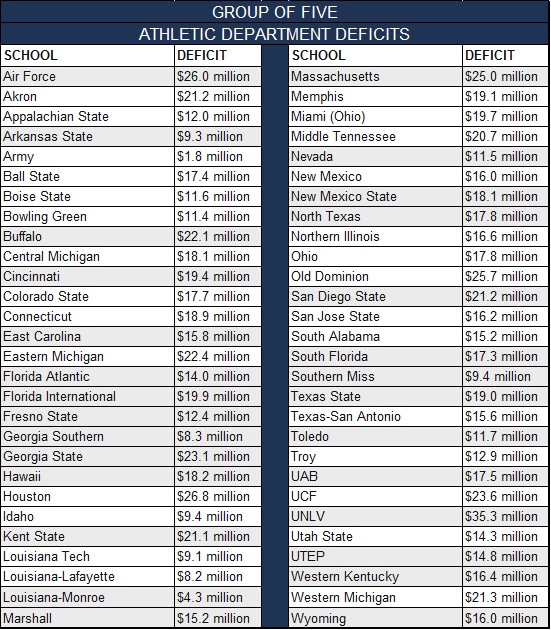In December of 2014, the University of Alabama at Birmingham (UAB) made headlines by shutting down their football program for good. UAB President Ray Watts simply found it too costly from both an operating and a capital investment standpoint to run the football program. To quote him specifically,
“As we look at the evolving landscape of NCAA football, we see expenses only continuing to increase. When considering a model that best protects the financial future and prominence of the athletic department, football is simply not sustainable.”
The last program to shut down major college football was Pacific in 1995, but looking at financial data from USA Today Sports[1] UAB is not alone in its “financial difficulties.”
The vast majority of athletic departments for programs from the Group of Five (otherwise known as universities from mid-major conferences) are running significant deficits (See complete listing below in Appendix A).
And what makes this financial situation worse is the fact that a majority of these public universities receive subsidies from student fees, direct and indirect institutional support and state money to help offset their costs.
But unfortunately even with their financial subsidies, the average deficit faced by 56 of the 63 mid-major athletic departments stood at $16.8 million for the 2012-13 financial years, and this year the figures are no different.
In May of 2012 as part of a research paper on the BCS (see my first blog post here), I argued that Division I Football needed to downsize and the Group of Five schools were the sacrificial lambs. My argument was based on the simple fact that television revenue is the only means to generate financially self-sufficient athletic departments, and the Power 5 Conferences and Notre Dame will continue to obtain the lion’s share of the television network revenue. Regardless of whether or not you feel this is fair or unfair, these are the facts as Power 5 Conference schools have significantly larger fan bases across more regions of the U.S. than Group of Five schools, and television networks are willing to pay for their viewership.
With the new College Football Playoff era, the television payouts have only gotten bigger and bigger. In 2011, the total payout across all the BCS bowls and non-BCS bowl games amounted to approximately $303 million. For the exclusive rights to broadcast the seven games of the College Football Playoff each year, ESPN is paying a reported $7.3 billion over 12 years. This package includes the four major bowl games, two semifinal New Year’s Day bowl games, and the national championship. ESPN is willing to pay an approximate $606.3 million annually for the right to broadcast seven games and this is on top of all the other large sums of money that they already shell out to the Power Five Conferences for the regular season games! After the CFP executives have taken their cut, the conference payouts break out as follows[2]:
With 14 members in Conference USA, 13 in the Mid-American conference, 12 in the American Athletic conference, 12 in the Mountain West, and 12 in the Sun Belt, the 63 member schools of the Group of Five split $60.0 million among themselves; And if they split it equally, this breaks down to roughly $953K per school. Given these measly contributions from television revenue, the question remains how in the world are the member schools of the Group of Five supposed to drive financially self-sufficient athletic departments and still support football programs?
Since 1999 no Group of Five football team has had more success than the Boise State Broncos.They have won three Fiesta Bowls during that time frame and they have finished in the Top 25 ten times with an average final ranking of 11.4 in the AP Poll and 10.6 in the Coaches Poll during this time frame.
And this past year, Boise State continued its rise by defeating Pac-12 school Arizona 38-30 in the Fiesta Bowl. Given this unprecedented success, one would expect that of all the Group of Five schools, the Boise State athletic department would be the closest to financial self-sufficiency. Unfortunately as the chart in Appendix A below details, Boise State’s on the field success hasn’t led to financial self-sufficiency for the athletic department. So I return to this question of financial self-sufficiency …
How does a member school of the Group of Five drive a financially self-sufficient athletic department while supporting football?
The short and simple answer is schools from the Group of Five simply can’t support collegiate football at the highest level, and athletic departments that strive to be financially self-sufficient will have to make the hard choice to sacrifice football. The long and complex answer lies around further conference expansion and inclusion of certain member schools from the Group of Five into the Power 5 Conferences. As expansion talks continue to heat up within the Big XII, mid-major football programs like Boise State, Cincinnati, Memphis, and University of Central Florida (UCF) to name a few will continue to be tossed around as potential candidates for inclusion. But the reality is without inclusion into one of the five power conferences, universities from the Group of Five have zero chance of closing the financial gap.
**One thing to note is that financial information for private institutions is very challenging to come by so my analysis for this post has focused on public universities only**
Appendix A – Significant Deficits run by Group of Five School for Financial Year 2012-13
[1]Jon Solomon. (November 25, 2014). UAB football isn’t alone in losing money for athletic departments. Retrieved from http://www.cbssports.com/collegefootball/writer/jon-solomon/24839675/uab-football-isnt-alone-in-losing-money-for-athletic-departments
[2]Kristi Dosh. (December 8, 2014). College Football Playoff: Conference Payouts. Retrieved from http://businessofcollegesports.com/2014/12/08/college-football-playoff-conference-payouts/






